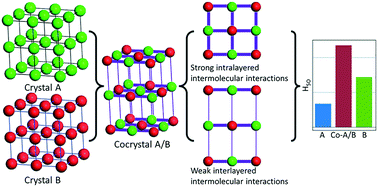Enhancing intermolecular interactions and their anisotropy to build low-impact-sensitivity energetic crystals
Abstract
Creating new energetic materials (EMs) of high energy and high safety (low sensitivity) is one of the most important objectives of research related to EMs. In addition to the synthesis of new compounds, constructing new EMs by crystal engineering is currently recognized to be a breakthrough. In the present work, we reveal the underlying mechanism of the observed impact sensitivity (IS) variations of the cocrystal series of diacetone diperoxide—(DADP)/1,3,5-trichloro-2,4,6-trinitrobenzene (TCTNB), DADP/1,3,5-tribromo-2,4,6-trinitrobenzene (TBTNB), and DADP/1,3,5-triiodo-2,4,6-trinitrobenzene (TITNB)—in comparison to their pure components, from the viewpoint of their crystal packing structures. We find that: the remarkable IS improvement of DADP/TITNB results from increased intermolecular interactions and the enhanced anisotropy of these interactions (i.e., the enhanced differentiation between intra- and interlayered interactions); the difficulty in measurement of the IS of DADP/TBTNB stems from its thermodynamic instability (weakened intermolecular interactions); and DADP/TCTNB shows an IS intermediate between those of its two pure components, as it does little to improve the interactions and anisotropy. Therefore, we propose the enhancement of intermolecular interactions and their anisotropy as a strategy for building low-impact-sensitivity EMs in crystal engineering, such as by cocrystallization.



 Please wait while we load your content...
Please wait while we load your content...